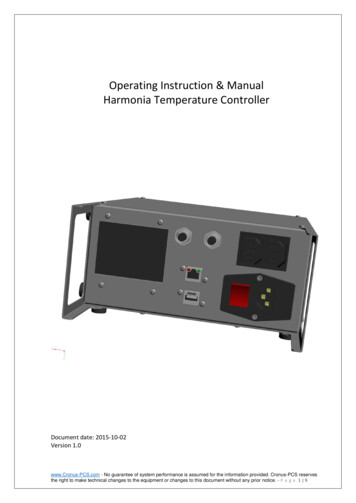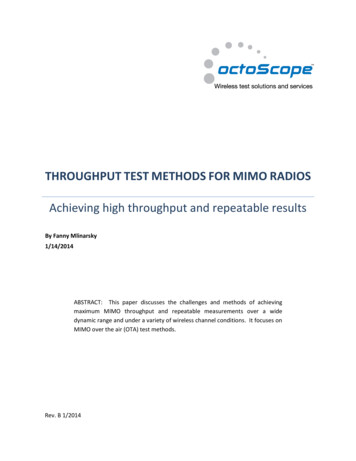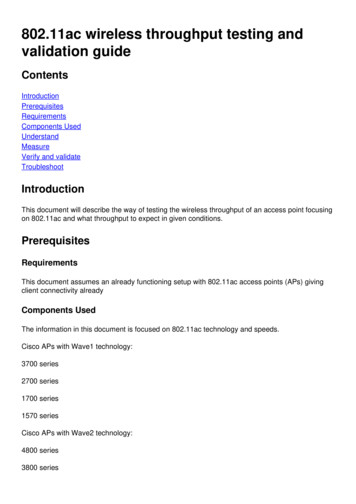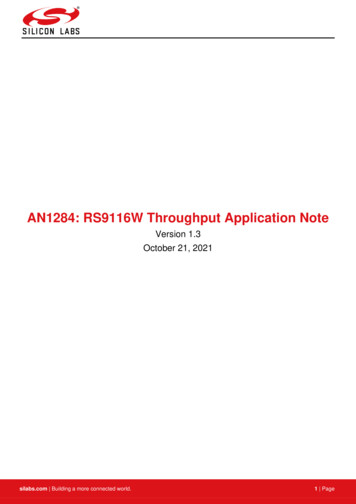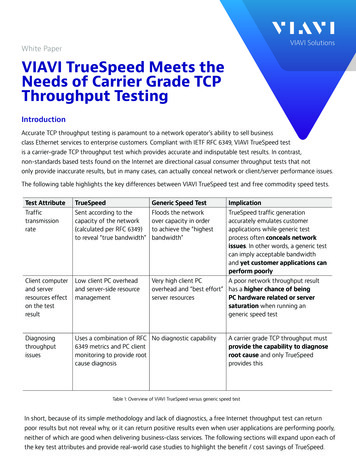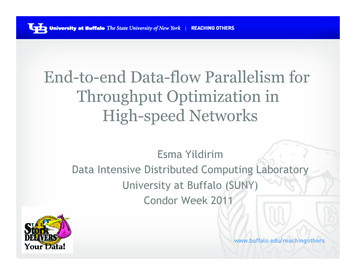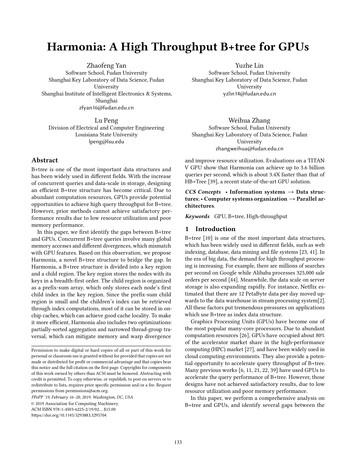
Transcription
Harmonia: A High Throughput B tree for GPUsZhaofeng YanYuzhe LinSoftware School, Fudan UniversityShanghai Key Laboratory of Data Science, FudanUniversityShanghai Institute of Intelligent Electronics & Systems,Shanghaizfyan16@fudan.edu.cnSoftware School, Fudan UniversityShanghai Key Laboratory of Data Science, FudanUniversityyzlin14@fudan.edu.cnLu PengWeihua ZhangDivision of Electrical and Computer EngineeringLouisiana State Universitylpeng@lsu.eduSoftware School, Fudan UniversityShanghai Key Laboratory of Data Science, FudanUniversityzhangweihua@fudan.edu.cnAbstractand improve resource utilization. Evaluations on a TITANV GPU show that Harmonia can achieve up to 3.6 billionqueries per second, which is about 3.4X faster than that ofHB Tree [39], a recent state-of-the-art GPU solution.B tree is one of the most important data structures andhas been widely used in different fields. With the increaseof concurrent queries and data-scale in storage, designingan efficient B tree structure has become critical. Due toabundant computation resources, GPUs provide potentialopportunities to achieve high query throughput for B tree.However, prior methods cannot achieve satisfactory performance results due to low resource utilization and poormemory performance.In this paper, we first identify the gaps between B treeand GPUs. Concurrent B tree queries involve many globalmemory accesses and different divergences, which mismatchwith GPU features. Based on this observation, we proposeHarmonia, a novel B tree structure to bridge the gap. InHarmonia, a B tree structure is divided into a key regionand a child region. The key region stores the nodes with itskeys in a breadth-first order. The child region is organizedas a prefix-sum array, which only stores each node’s firstchild index in the key region. Since the prefix-sum childregion is small and the children’s index can be retrievedthrough index computations, most of it can be stored in onchip caches, which can achieve good cache locality. To makeit more efficient, Harmonia also includes two optimizations:partially-sorted aggregation and narrowed thread-group traversal, which can mitigate memory and warp divergenceCCS Concepts Information systems Data structures; Computer systems organization Parallel architectures.Keywords GPU, B tree, High-throughput1IntroductionB tree [10] is one of the most important data structures,which has been widely used in different fields, such as webindexing, database, data mining and file systems [23, 41]. Inthe era of big data, the demand for high throughput processing is increasing. For example, there are millions of searchesper second on Google while Alibaba processes 325,000 saleorders per second [44]. Meanwhile, the data scale on serverstorage is also expanding rapidly. For instance, Netflix estimated that there are 12 PetaByte data per day moved upwards to the data warehouse in stream processing system[2].All these factors put tremendous pressures on applicationswhich use B tree as index data structure.Graphics Processing Units (GPUs) have become one ofthe most popular many-core processors. Due to abundantcomputation resources [26], GPUs have occupied about 80%of the accelerator market share in the high-performancecomputing (HPC) market [27], and have been widely used incloud computing environments. They also provide a potential opportunity to accelerate query throughput of B tree.Many previous works [6, 11, 21, 22, 39] have used GPUs toaccelerate the query performance of B tree. However, thosedesigns have not achieved satisfactory results, due to lowresource utilization and poor memory performance.In this paper, we perform a comprehensive analysis onB tree and GPUs, and identify several gaps between thePermission to make digital or hard copies of all or part of this work forpersonal or classroom use is granted without fee provided that copies are notmade or distributed for profit or commercial advantage and that copies bearthis notice and the full citation on the first page. Copyrights for componentsof this work owned by others than ACM must be honored. Abstracting withcredit is permitted. To copy otherwise, or republish, to post on servers or toredistribute to lists, requires prior specific permission and/or a fee. Requestpermissions from permissions@acm.org.PPoPP ’19, February 16–20, 2019, Washington, DC, USA 2019 Association for Computing Machinery.ACM ISBN 978-1-4503-6225-2/19/02. . . 15.00https://doi.org/10.1145/3293883.3295704133
PPoPP ’19, February 16–20, 2019, Washington, DC, USAZhaofeng Yan, Yuzhe Lin, Lu Peng, and Weihua Zhangcharacteristics of B tree and the features of GPUs. For traditional B tree, a query needs to traverse the tree from root toleaf, which would involve many indirect memory accesses.Moreover, two concurrent executed queries may have different tree traversal paths, which would lead to differentdivergences when they are processed in a GPU warp simultaneously. All these characteristics of B tree are mismatchedwith the features of GPUs, which impede the query performance of B tree on GPUs.Based on this observation, we propose Harmonia, a novelB tree structure, to bridge the gaps between B tree andGPUs. In Harmonia, the B tree structure is partitioned intotwo parts: a key region and a child region. The key regionstores the nodes with its keys in a breadth-first order. Thechild region is organized as a prefix-sum array, which onlystores each node’s first child index in the key region. Thelocations of other children can be obtained based on theseindex number and the node size. With this compression,most of the prefix-sum array can be stored in GPU caches.Therefore, such a design matches GPU memory hierarchy forgood cache locality and can avoid indirect memory accesses.To further improve the query performance of Harmonia,we propose two optimizations including partially-sorted aggregation (PSA) and narrowed thread-group traversal (NTG).For PSA, we sort the queries in a time window before issuingthem. Since adjacent sorted queries are more likely to sharethe same tree traversal path, it increases the opportunity ofcoalesced memory accesses when multiple adjacent queriesare processed in a warp. For NTG, we reduce the number ofthreads for each query to avoid useless comparisons. Whenthe thread group for each query is narrowed, more queriescan be combined into a warp, which may increase warp divergence. To mitigate the warp divergence problem broughtby query combinations, we design a model to decide how tonarrow the thread group for a query.Experimental results show Harmonia can achieve a throughput of up to 3.6 billion queries per second on a TITAN V GPU,which is about 3.4X higher than that of HB tree [39], a recent state-of-the-art GPU solution. The main contributionsof our work can be summarized as follows: Analysis on the gaps between B tree and GPUs. A novel B tree structure which matches GPU memoryhierarchy well with good locality. Two optimizations to reduce divergences and improveGPU computation resource utilization.The rest of this paper is organized as follows. Section 2 introduces the background and discusses our motivation. Section3 gives out Harmonia structure and tree operations. Section4 introduces two optimizations applied on Harmonia treestructure. Section 5 shows the experimental results. Section6 surveys the related work. Section 7 concludes the work.1342Background and MotivationThis section first introduces the background. Then, the gapsbetween GPUs and B tree are discussed.2.1 General-Purpose GPUsGraphics Processing Units (GPUs) are one of the most popular many-core processors and have been widely used indifferent fields, such as HPC and big data processing. Atypical GPU architecture is shown in Figure 1. There aremultiple stream multiprocessors (SMs) in a GPU. Each SMhas multiple CUDA cores with software configurable sharedmemory (L1 cache) and read-only data cache. GPUs alsohave several memory hierarchy layers shared by all SMsincluding L2 cache, constant memory, texture memory, andoff-chip global memory. Among them, global memory is theslowest one, which generally requires several hundred cyclesto access.GPUGPUSM 1Register FileFRUHF RUH F RUHSM n Shared Memory(L1 Cache)Read-Only Data CacheL2 CacheConstant MemoryTexture MemoryGlobal MemoryFigure 1. An overview of Nvidia GPU ArchitectureTo utilize the computation resources in an SM, multipleconsecutive threads, e.g., 32 threads, are organized into awarp. Each thread is executed on a CUDA core and thethreads in a warp are executed in a single instruction multiple thread (SIMT) manner. Multiple warps compose a threadblock that can be dispatched to a specific SM. The warpson the same SM are scheduled to hide long memory accesslatency. The thread blocks further constitute a GPU kernel,which is a parallel function that can be invoked by the programmer and executed on all the SMs in a GPU.Since the instructions are issued and executed at a warpgranularity, executing different instructions among the threadsin a warp will bring warp divergence [1]. Moreover, memoryoperations are also issued per warp. If a batch of memoryaddresses requested by a warp fall within one GPU cacheline, which is called coalesced memory access [1, 20], theycan be served by single memory transaction. Therefore, thecoalesced memory access pattern can improve the memory
PPoPP ’19, February 16–20, 2019, Washington, DC, USAload efficiency and throughput. Otherwise, multiple memory transactions will be required, which leads to memorydivergence [11, 47].GPUs provide powerful computation resources and highmemory bandwidth. To fully utilize them, an applicationshould have the following characteristics.Reducing global memory accesses. Global memory accessesare performance bottlenecks for GPUs. Therefore, increasingon-chip data locality and reducing global memory accessesare critical to improving performance.Avoiding warp divergence. When warp divergence happens, the threads in a warp execute different instructions.Since the threads in a warp are executed in the SIMT mode,they have to be partitioned into several sub-groups basedon the instructions. When the threads in a sub-group areexecuted, the other threads have to wait, which leads to lowresource utilization.instead of mixing search and update operations to achievehigh lookup performance. With data scale increasing, it hasbecome more and more critical that how to further improveB tree query performance.It seems that GPU is a potential solution to acceleratingsearch performance of B tree due to its powerful computation resources. However, prior GPU-based B tree methodscannot achieve satisfactory performance results. To understand the underlying reasons, we perform a detailed analysisand uncover three main sources of the performance gapsbetween B tree and GPUs.Gap in Memory Access Requirement. Each B tree queryneeds to traverse the tree from root to leaf. This traversalbrings lots of indirect memory accesses, which is proportional to tree height. For instance, if the height of a B tree isfive, there are four indirect global memory accesses whena query traverses the tree from root node to its target leafnode. However, a large number of global memory accessesin tree traversal would lead to poor memory performanceon GPUs.Avoiding memory divergence. Memory divergence leadsto multiple memory transactions which impose long delayson GPU applications. Therefore, avoiding memory divergence is important for GPU performance.4Average mem-tranactions3.52.2 Gaps between GPUs and B treeB tree is a self-balanced tree [10] where the largest numberof children in one node is called fanout. Each internal nodecan store no more than fanout-1 keys and fanout child references. There are two kinds of B tree organizations: regularB tree and implicit B tree [29]. For regular B tree, eachnode in B tree contains two types of information: key information and child reference information. Child referencesare used to get the child locations. For implicit B tree, thetree is complete and only contains key information, whichis arranged in an array with the breadth-first order. ImplicitB tree achieves the child locations using index computations. It has to restructure the entire tree for some updateoperations, such as insert or delete. Since restructuring treestructure is very time consuming, we mainly focus on regularB tree in this paper.For B tree, when a query is performed, it traverses thetree from the root to a leaf level by level. At each tree level,the query visits one node. It first compares with the keys heldby current node to find a child whose corresponding rangecontains the target key. Then it accesses the child referenceto fetch the target child’s position as the next level node tovisit.Because of high query throughput and the support of order operations, such as range query, B tree has been widelyused in different fields like web indexing, file systems, anddatabases. Since search performance is more important forlookup-intensive scenario, such as online analytical processing (OLAP), decision support systems and data mining.[15, 39, 45, 46], B tree systems typically use batch update3.253.1632.521.5110.50WorstQueriesBestFigure 2. Average memory transactions per warpGap in Memory Divergence. Since the target leaf node ofa query is generally random, multiple queries may traversethe tree along different paths. When they are processed simultaneously, such as in a GPU warp, the memory accessesare disordered, which would lead to memory divergenceand greatly impede the GPU performance. To illustrate it,we collect the average number of memory transactions foreach warp when concurrent queries traverse B tree. For aheight-4 and fanout-8 B tree, each warp processes 4 queriesconcurrently and the input query data are randomly generated based on uniform distribution. As shown in Figure 2, theaverage number of memory transactions for each warp (illustrated in the second bar) is 3.16, which is about 97% ofthe worst case (3.25) shown in the first bar of Figure 2. Forthe worst case, 4 queries access the root node in a coalescedmanner, so it just needs 1 memory transaction. For the otherlevels, 4 queries access different nodes for the worst case, soit requires 4 memory transactions for each level. Therefore,135
PPoPP ’19, February 16–20, 2019, Washington, DC, USAZhaofeng Yan, Yuzhe Lin, Lu Peng, and Weihua Zhangthe memory divergence is very heavy for an unoptimizedGPU-based B tree.01K1Average query comparisonsGap in Query Divergence. Since the target leaf node ofa query is random, multiple queries may require differentamounts of comparison operations in each level traversal,which would lead to query divergence. To illustrate this problem, we collect the comparison numbers of 100 queries ineach level based on the above experiment setting and computed the average number, the largest one and the smallestone. As shown in Figure 3, the comparison numbers of eachlevel for different queries have a large fluctuation althoughaverage comparison number is close to 4. Therefore, processing these queries simultaneously in a warp would lead towarp divergence and memory divergence.54 61K321 1K)NORJ)NORJ )NORJ . . .87 Regular B tree(a) Regular B tree structureKey RegionKeyKeyKey . Key Array012345678 Store in GPU Global Memory6Child Region5ChildPrefix-Sum Array1 4 6 7 9 4Store in GPU Cache3(b) Harmonia tree structure21Figure 4. Regular B tree and Harmonia B tree01234tree levelregion is organized in node granularity and the size of eachitem (a node) is fixed ((fanout-1)*key size). The child regionis organized as a prefix-sum array. Each item in the array isthe node’s first child index in the key region, which equals tothe node number in the key region before its first child. Forexample, the prefix-sum child array of the regular B tree inFigure 4(a) is [1, 4, 6, 7, 9.]. It means the first child index ofnode 0 (root) is 1, and the first child index of node 1 is 4 andso on. The children number in a node can be obtained by theprefix-sum value of its successor node minus its prefix-sumvalue. Moreover, the index of any child in the key region canbe obtained through simple index computation.In this organization, the size of the prefix-sum child arrayis small. For example, for a 64-fanout 4-level B tree, the sizeof its prefix-sum array at most is only about 16KB. Therefore,most of the prefix-sum child array, even a very large B tree,can be saved in low-latency on-chip caches in GPU memoryhierarchy, such as constant memory, which can improvememory locality.In our current design, the top level of the prefix-sum childarray is stored in the constant memory 1 , and the rest isfetched into the read-only cache on each SM when they areused. In this way, the prefix-sum array accesses will be moreefficient than the child references of regular B tree.Figure 3. Query divergence3Harmonia Tree StructureTo make the characteristics of B tree match the features ofGPUs, we propose a novel B tree structure called Harmonia.In this section, we first present Harmonia tree structure.Then we introduce its operations.3.1 Tree Structure OverviewIn a traditional regular B tree structure, a tree node consists of keys and child references as shown in Figure 4(a).A child reference is a pointer referring to the location ofthe corresponding next level child. In this organization, thesize of each node is large. For example, the size of a nodeis about 1KB for a 64-fanout tree. Since the target of eachquery is random, it is difficult to utilize the GPU memoryhierarchy to explore different types of locality. Moreover, thenext child location is obtained through the reference pointer,which will involve many indirect global memory accesses.Therefore, the memory performance of traditional regularB tree is poor on GPUs.To overcome these constraints and fit GPU memory hierarchy better, the tree structure is partitioned into two partsin Harmonia: a key region and a child region. The key regionis a one-dimensional array which holds the key informationof original B tree nodes in a breadth-first order. The key1 Theconstant memory on GPU is read-only and faster than global memory,and it doesn’t need to reload after current kernel finish, but it has a limitsize (64KB in Nvidia Kepler) which is usually smaller than the prefix-sumchild array.136
PPoPP ’19, February 16–20, 2019, Washington, DC, USAAlgorithm 1 Syn For Tree Update3.2 Tree OperationBased on the above design, we further describe how Harmonia handles common B tree operations in a batch updatescenario, including search, range query, update, insert anddelete. Batch update scenario is phase-based because updatesare relatively infrequent [28] and can be deferred [33, 40].For example, it was reported that there is a high read/writeratio (about 35:1) in TPC-H [28]. Therefore, in Harmonia’squery phase, the GPU is used to accelerate query performance. In the update phase, batched updates are processedon CPUs; The B tree on the GPU is synchronized after theupdates.1:if Operations updates without split or merge then2://Locking strategy of updates without split or merge3:LOCK(coarse lock)global count RELEASE(coarse lock)4:5:6:7:8:9:LOCK(node.fine lock)operation without split or merge()RELEASE(node.fine lock)10:11:12:3.2.1 Search and Range QueryTo traverse a B tree, a query needs to search from the treeroot to the target leaf level by level. For each level of B tree,the query first compares with the keys in the current node (anitem of the key region) and finds the child whose corresponding range contains the target key. Suppose the ith child isthe target child and current node index is node idx. Sincethe prefix-sum child array contains the first child’s index,the ith child’s index can be computed through Equation 1and the next level node can be obtained through accessingthe key region.13:14:15:16:17:18:19:20:21:22:23:24:child idx PrefixSum[node idx] i 1(1)For example, when we are at the root node whose node idxis 0 and try to visit its second child (i 2), we will calculatechild idx with Equation 1, so the child index of root in thekey region is 2. Therefore, we can get the next level nodebased on its index (2) in the key region.After the target leaf node is reached and the target key isfound, a query is finished. For a range query, it can use thebasic query operation to get the first target key in the range,and scan the key region from the first target key to the lasttarget key in the query range. Since the key region is a consecutive array, range queries can achieve high performance.25:LOCK(coarse lock)global count-RELEASE(coarse lock)else//Locking strategy of updates with split or mergeRETRY:LOCK(coarse lock)if global count 0 thenoperation with split or merge()RELEASE(coarse lock)elseRELEASE(coarse lock)goto RETRYend ifend ifnodes after the created node must be moved backward sothe new node can be inserted into the key region, while thecorresponding prefix-sum array items need to be updateddue to the change of key region item location.When multiple updates are processed in a parallel manner,thread safe must be guaranteed. In our current design, asimple locking strategy with two grained lock is used.If an operation leads to a change of tree structure likesplit (in insert) or merge (in delete), a coarse-grained lock isused to protect the entire tree. Otherwise, a fine-grained lockis used to protect the particular target leaf node. Moreover,there needs a mechanism, as shown in Algorithm 1, to avoidconflicts between the coarse-grained lock and fine-grainedlocks. To achieve this goal, a global counter is used to recordthe number of in-process updates with fine-grained locks.The coarse-grained lock is also used to protect global counteraccesses. When an operation needs to update the tree, itneeds to first get the coarse-grained lock in order to updatethe global counter or check whether it is zero. If it is anupdate without split or merge (Lines 3-13), it increases theglobal counter by one after acquiring the coarse-grainedlock, then releases the coarse-grained lock. Then, it locksthe target leaf using the corresponding fine-grained lock.After the operation is completed, the fine-grained lock isreleased and the global counter is decreased by one withthe protection of the coarse-grained lock; If an operation3.2.2 Update, Insert and DeleteFor an update (update an existing record’s value) operation, it is similar to a query. After the target key is acquired,the value is updated. Compared with update, insert (insert anew record) and delete (delete an existing record) are morecomplex because they may change the tree structure. Sinceinsert and delete are a pair of inverse operations, we mainlydiscuss the details of insert here.For a single insert operation, it needs to retrieve the targetleaf node through a search operation. If the target leaf nodeis not full, the record will be inserted into the target node.When the target node is full, the target node needs to besplit and a new node will be created. Because the currentkey region is organized in a consecutive way, when a newnode is created, the key region has to be reorganized. The137
PPoPP ’19, February 16–20, 2019, Washington, DC, USAZhaofeng Yan, Yuzhe Lin, Lu Peng, and Weihua ZhangQueriesleads to a split or merge (Lines 16-24), it needs to get thecoarse-grained lock and check whether the global counter iszero. If so, it will finish its operations and release the lock.Otherwise, it will release the lock first to avoid deadlock andretry the step. Through such a design, the thread safety canbe guaranteed.Although this design can process the update operations,the memory movement of key region due to node splittingor merging will involve an enormous overhead. To reducethe overhead, the memory movements are performed aftera batch of update operations are finished. To support sucha design, Harmonia uses auxiliary nodes to update the treestructure for node splitting. When an insert causes one nodeto split, an auxiliary node is created and the node status ismarked as split. The auxiliary node contains the entire childreferences, and the split is processed on the auxiliary node.During the period of batch update, we need to first checkwhether or not the leaf node status is split for an insert. Ifit is, a new insert or update will use the information of itsauxiliary node. Otherwise, it will use the original node inthe key region.After all update operations in a batch are done, the treestructure might not follow the rules of Harmonia. Therefore,we need to update the auxiliary node’s information intoHarmonia to maintain the tree structure of Harmonia. Thekey region is extended first and some original items in thekey region are moved backward to make room for the newlycreated nodes. And then put the auxiliary nodes in the rightlocation. Since the locations of all these data movementscan be known in advance, some of them can be processed inparallel.Movements after batch can improve update throughputsignificantly and achieve comparable performance with thoseof the multi-thread traditional B tree and the state of the artGPU B tree as the data shows in Section 5 (Figure 14).4target 220 351 Figure 5. B treethese concurrent queries in a warp would lead to poor GPUperformance due to memory divergence. In this section, wewill propose a partially-sorted aggregation for better memoryperformance.4.1.1 Sorted AggregationIf multiple queries have shared part of the traversal path, thememory accesses can be coalesced when they are processedin a warp. For instance, if the queries with target 1 and target2 in Figure 5 are processed in a warp, there are coalescedmemory accesses for their first two level traversals.For two concurrent queries, they will have more opportunities to share a traversal path if they have closer targets. Toachieve this goal, a solution is to sort the queries in a timewindow before they are issued. For the example in Figure 5,the query target sequence becomes 1, 2, 20, and 35 aftersorting as Figure 7 shows. When two adjacent queries arecombined into a warp, the warp with the first two querieswill have coalesced memory accesses for their shared traversal path as shown in Figure 6(b). Moreover, because thequeries in the same warp will go through the same path, itcan also mitigate warp divergence among them.Although sorting queries can reduce memory divergenceand warp divergence, it brings additional sorting overhead.To illustrate this problem, we evaluate the overhead usingGPU radix sort [12] to make a batch of queries sorted beforeassigning them to the B tree concurrent search kernel. Asthe data in Figure 8 show, the kernel performance has about22% improvement compared with that of the original one.However, there is about 7% performance slowdown for thetotal execution time. The reason behind this is that completesorting will generate more than 25% overhead.Harmonia OptimizationsTo reduce divergences and improve computation resourceutilization on GPUs, we further introduce two optimizationsfor Harmonia including partially-sorted aggregation (PSA)and narrowed thread-group traversal (NTG).4.1 Partially-Sorted Aggregation (PSA)When an application is executed on a GPU, the most efficientmemory access manner is coalesced. For B tree, the targetsof multiple queries are generally random. When adjacentqueries are processed in a warp, it is difficult to achieve acoalesced memory access because they would traverse thetree along different paths. Figure 5 shows an example. Fourquery targets are 2, 20, 35 and 1 individually. When theytraverse the tree and two adjacent queries are combined intoa warp, there is no coalesced memory access after they leavethe root node, as shown in Figure 6(a). Therefore, processing4.1.2 Partially-Sorted AggregationTo achieve a coalesced memory access, multiple memoryaccesses in a warp only need to fall into the address spaceof a cache line even they are unordered. As shown in Figure 6(c), although the query to target 2 is before the query totarget 1, we can still achieve coalesced memory accesses fortheir shared path, which has the same effect with that of thecompletely sorted queries as shown in Figure 6(b). Therefore,138
PPoPP ’19, February 16–20, 2019, Washington, DC, USA GXV GXV GXV GXV GXV Global memoryGlobal memoryCache line sizeMemory divergence(a) Queries GXV Global memoryCache line size(b) Sorted queries(c) Partially-sorted queriesFigure 6. An example of memory access pattern for queries.Queriestarget1 220overall performance has about 10% improvement comparedwith that of the original one.For a partial sorting, the queries will be sorted based ontheir most significant N bits. If N is large, there is a high probability that the targets of sorted queries are closer. However,it will lead to a higher sorting overhead. Here, we discusshow to decide the PSA size to achieve a better trade-off between the number of coalesced memory accesses and thesorting overhead. Suppose each key is represented by B bits,the size of traversed B tree is T and a cache line can save Kkeys. In this condition, the key range is 2B and each existingkey in the tree can averagely cover the key range of 2B /T .The keys in a cache line can cover the key range of 2B /T Kand the bits to represent this range is log2 (2B /T K) on average. If the memory requests of multiple queries in a warpfall in the covering range of a cache line, no matter whetherthey are sorted or not, they are coalesced memory accesses.Therefore, it is unnecessary to sort the queries when theirtarget keys fall in the same cache line. Based on the aboveanalysis, the value of N can be calculated using Equation 2.Note, our analysis is conservative because we suppose thekey value is full in its space. In reality, the key number issmaller than its space size. Therefore, it is possible that thetargets exceeding the covering range of a cac
Harmonia, a novel B tree structure to bridge the gap. In Harmonia, a B tree structure is divided into a key region and a child region. The key region stores the nodes with its keys in a breadth-first order. The child region is organized as a prefix-sum array, which only stores each node's first child index in the key region. Since the prefix .


